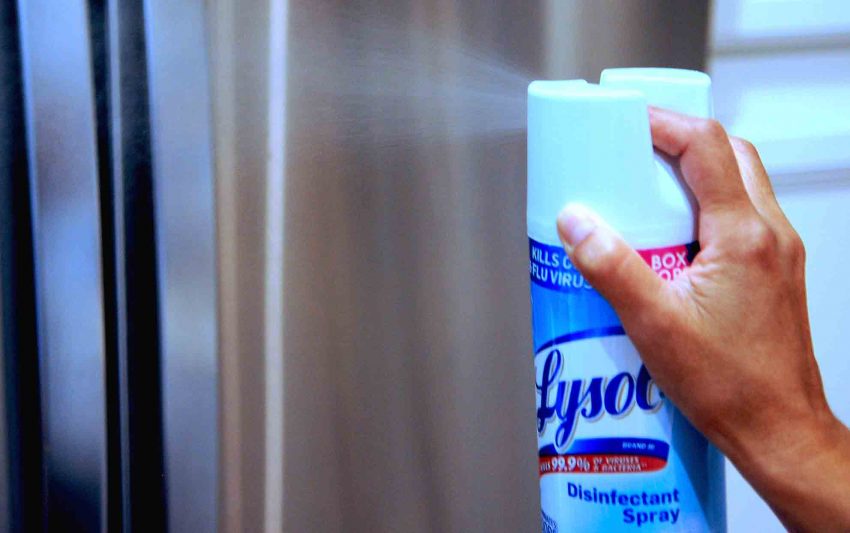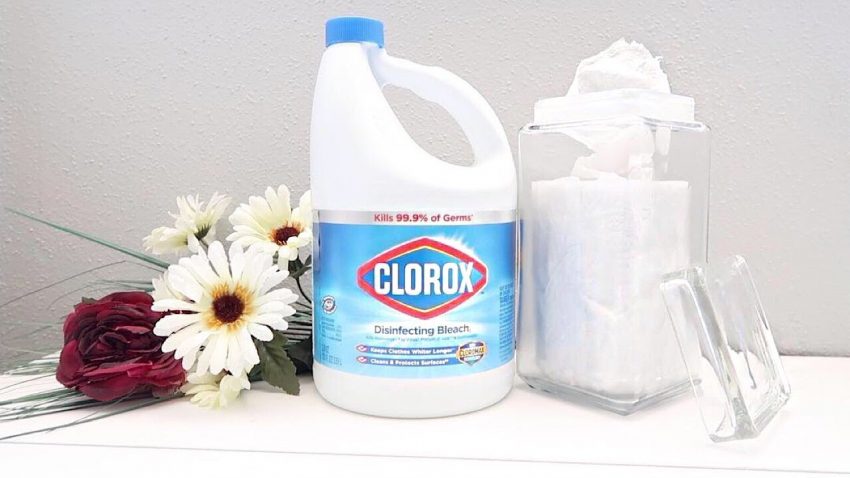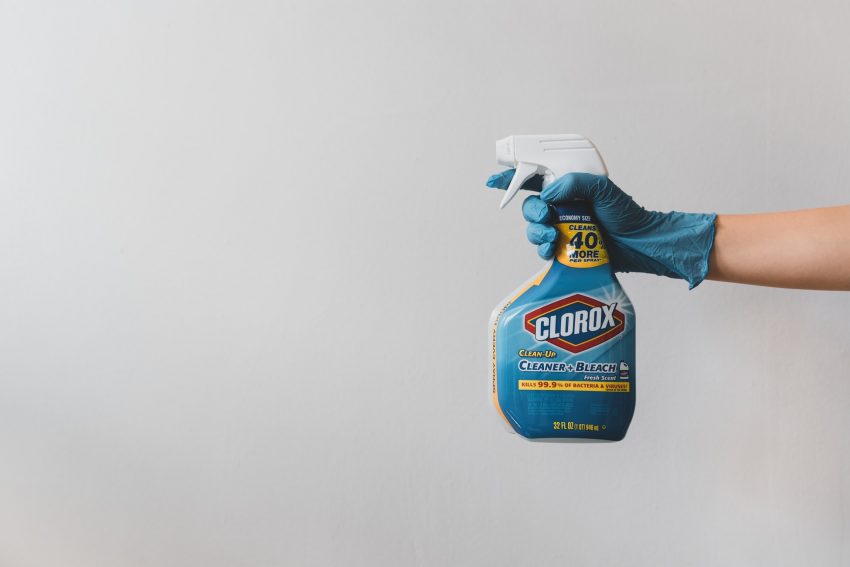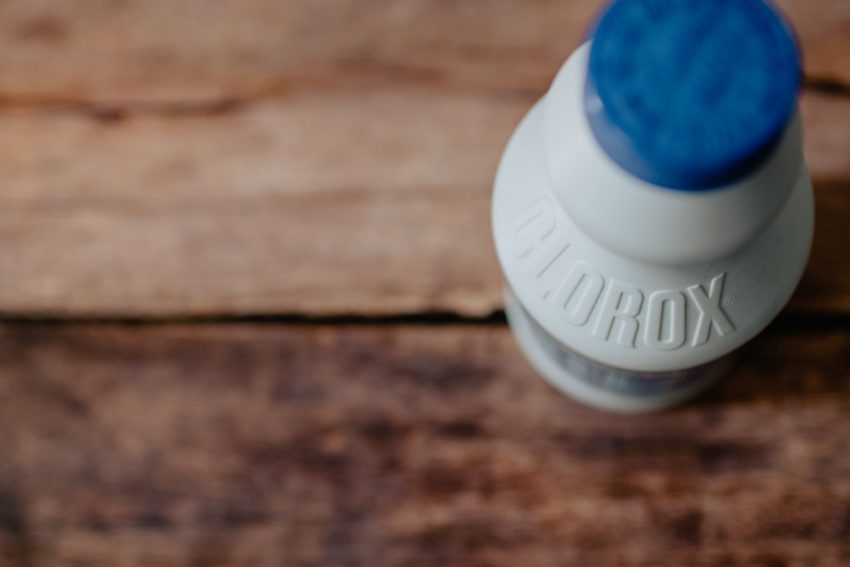Clorox Bleach vs Lysol — Which is better for protecting against COVID-19?
What is Clorox bleach?
Clorox is one of the biggest bleach manufacturing companies in the U.S., and has been a trusted household brand for over a century. The active ingredient in Clorox Disinfecting Bleach is sodium hypochlorite, which is marketed in a 7.5 percent solution. That’s stronger than the traditional 6 percent solution used in earlier formulations, and is designed to kill 99.9 percent of germs and bacteria.
The sodium salt of hypochlorous acid, sodium hypochlorite is the earliest known and most common chlorine-based bleach. As the active ingredient in Clorox bleach, it is used for its germicidal properties. Sodium hypochlorite is an unstable compound that decomposes to release chlorine, which is why you should only use bleach in well-ventilated areas, and never mix Clorox bleach with other cleaners, particularly ammonia or acids, as you risk creating toxic byproducts.
Clorox Disinfecting Bleach active ingredients |
|
INGREDIENT |
USE |
Sodium hypochlorite |
Antimicrobial. Breaks down into chlorine. |
Sodium chlorate |
The result of the natural breakdown of sodium hypochlorite. Further breaks down into sodium chloride and oxygen. |
Sodium chloride |
Table salt. Used to stabilize and thicken. |
Sodium carbonate |
Washing soda. Breaks down grease stains and softens water. |
Sodium hydroxide |
Caustic soda/lye. Removes fatty, oily, and acidic stains. |
The remaining ingredients are coagulants that change the consistency of the bleach, and antistatic agents that prevent new stains from taking hold on the material or surface being cleaned.
Clorox Disinfecting Bleach and its active ingredient sodium hypochlorite appear on the EPA’s List N of solutions effective for use against the SARS-CoV-2 virus.

What is Lysol?
Lysol is another common brand that many employers and homeowners trust to keep their homes and workplaces clean and safe. Two Lysol products, Lysol Disinfectant Spray and Lysol Disinfectant Max Cover Mist, have been certified by the EPA as effective at killing the novel coronavirus. Lab tests showed both Lysol solutions kill the coronavirus on hard, nonporous surfaces within two minutes of contact.
Pro Tip: The EPA List N contains over 400 disinfecting products that have been tested against viruses and bacteria that are harder to kill than the coronavirus that causes COVID-19, but Lysol is the first that has been tested and proven effective against the novel coronavirus itself.
The active ingredients in both Lysol Disinfectant Spray and Lysol Disinfectant Max Cover Mist are a combination of ammonium compounds, biocides, and alcohol (ethanol). All these ingredients are chosen for their antiseptic and antimicrobial properties, and Lysol claims they can kill 99.9 percent of fungi, viruses, and bacteria, and inhibit the growth of mold and mildew for up to a week after application.
Lysol Disinfectant Spray active ingredients |
|
INGREDIENT |
USE |
Ethanol |
Alcohol. Antibacterial. |
Alkyl (50% C14, 40% C12, 10% C16) Dimethyl Benzyl Ammonium Saccharinate |
Ammonium-based biocides that target the proteins inside bacterial cells, destroying them. |
Both products have proven effectiveness against a range of other pathogens, including enterovirus, avian influenza, hepatitis A, polio, staph, and MRSA. However extensive use of ammonium-based biocides (also known as quaternary ammonium compounds, or “quats”) has been linked to an increase in antibiotic-resistant bacteria. As a result, you should limit your use of these chemicals to part of a structured cleaning regimen, rather than as an all-purpose cleaning solution.
How to use Clorox bleach against coronavirus
When using Clorox bleach as a disinfectant, it’s important to follow the instructions on the label in order to create an effective solution and apply it for maximum results. In particular, any disinfecting solution needs to be applied to a surface until it is wet, and then remain standing for approximately six minutes (the time will vary by solution and pathogen, so be sure to check the label for your specific needs). The most common mistake people make with disinfectants is failing to apply an adequate amount of solution to surfaces, or wiping away the solution too early, which can result in ineffective cleaning and a false sense of security.
Clorox bleach disinfectant always needs to be diluted prior to use. Follow the guidelines on the instructions for the proper dilution of bleach for disinfecting purposes, and avoid the temptation to increase the strength of the solution. Stronger bleach doesn’t always mean additional germ-killing power, and it can mean there’s more chance of damaging or discoloring surfaces where it is applied. Typically you need either ⅓ or ½ cup of Clorox bleach per gallon of water, depending on the product you purchase.
Pro Tip: Most modern bleaches can be diluted in water of any temperature, unlike older formulations that lost effectiveness in warm or hot water.
Clorox further advises consumers not to make a homemade spray cleaner with their bleach solution. This is because sodium hypochlorite will react with the metal in trigger sprayers and rust the assembly. This inhibits the cleaning properties of the solution, and risks staining any surfaces where it is applied. Instead, purchase a premade Clorox disinfecting spray that comes in a bottle designed without metal triggers.
How to use Lysol against coronavirus
Just as with Clorox bleach, Lysol cleaners must be applied in sufficient quantities, for enough time, in order to be effective against SARS-CoV-2. The instructions for Lysol Disinfectant Spray state that surfaces must be sprayed continuously for 3-4 seconds (long enough to be covered with mist) and allowed to remain wet for at least 3 minutes before air drying. Although studies have shown Lysol Spray is effective at killing the novel coronavirus after 2 minutes, other pathogens, such as norovirus, need longer exposure.
Whether you’re using bleach or Lysol to clean surfaces, they should always be pre-cleaned to remove any dirt, grime, or buildup that might lessen the solution’s effectiveness against pathogens.
Common cleaning mistakes to avoid
The CDC recently released a report showing that while businesses and individuals are cleaning more than ever, many are making mistakes with their cleaning methods that leave them exposed to COVID-19 and other illnesses. Over one third of adults (39 percent) used unsafe practices that risked causing them harm. A quarter of respondents reported adverse health effects that they believe were caused by improper use of cleaning solutions.
- Never wash food with bleach or household cleaning solutions
- Never apply cleaners to your bare skin
- Never inhale, ingest, or inject any cleaning products
- Never mix different cleaning solutions
Around 60 percent of respondents reported that they are cleaning their homes and workspaces more often and more thoroughly since the COVID-19 pandemic began, and a majority had good general knowledge of the precautions to take while using cleaning solutions.
- Always read the label and follow the instructions
- Always use appropriate personal protective equipment (PPE) such as gloves and eye shields
- Always wash your hands after using cleaning and disinfecting products
- Always store cleaning solutions out of reach of children and animals
While most adverse health effects of improper use of cleaning chemicals are mild, ranging from sinus irritation (11 percent of respondents) to dizziness, lightheadedness, and headaches (8 percent), more serious side effects can occur. Combining different cleaning solutions can create toxic fumes, and many cleaners have corrosive or irritant properties that can seriously damage respiratory systems and internal organs.
Always follow the instructions, ensure areas are well ventilated while being cleaned, keep animals and children away from cleaning solutions, and never apply bleach or disinfectant to foodstuffs or your skin.

Where to use Clorox or Lysol to guard against COVID-19
As all-purpose cleaning solutions, both Clorox bleach and Lysol have been tested for use on a multitude of surfaces.
Clorox Disinfecting Bleach should be used only on hard, nonporous surfaces. These include:
- Glass
- Plastic
- Metal
- Varnished wood
- Linoleum
- Laminate countertops
Clorox Disinfecting Bleach should not be used on exposed or waxed timbers, natural stone, or soft furnishings. You can clean almost any bathroom and kitchen surface, including vinyl shower curtains, toilets, bathtubs, sinks, faucets, countertops, and linoleum flooring with Clorox bleach, although it’s a good idea to test a small, inconspicuous area first.
Pro Tip: Get guidance on cleaning natural stone such as granite.
For office and workplace cleaning, Clorox bleach is a great all-purpose solution that’s safe to use on desks, chairs, counters, floors, windows, doors and door handles, walls, switches, and more. For medical practices, Clorox bleach can also be used to clean fixed equipment, beds, waiting areas, floors, doors, and reception desks.
Lysol Disinfectant Spray doesn’t contain bleach, and is therefore safer for use across a wider range of common surfaces, including toys, food contact surfaces, and fabrics, although if there is any risk of ingestion from any surface where Lysol has been applied, always rewash the surface with potable water after air drying.
Other Clorox and Lysol products that can be used against the coronavirus
Many people are understandably nervous about creating their own cleaning solution from bleach, or handling potentially hazardous chemicals. Both Clorox and Lysol manufacture ready-to-use cleaners in a variety of forms, such as disinfecting sprays and wipes, that are less risky to use. Clorox Disinfecting Wipes, for example, are as effective as Clorox bleach at killing 99.9 percent of germs and bacteria, including staph, E. coli, and salmonella.
Do Clorox wipes have bleach in them?
Clorox Disinfecting Wipes contain alcohol (hexoxyethanol, C12-14 alcohols ethoxylated propoxylated) and biocidal ammonium compounds (Alkyl C12-14 Dimethylethylbenzyl Ammonium Chloride, Alkyl C12-18 Dimethylbenzyl Ammonium Chloride) that have similar microbial properties to Lysol Disinfectant Spray. They are bleach-free wipes that can be safely used on a multitude of surfaces without requiring the same precautions that are necessary when using bleach.
What is in Lysol Disinfecting Wipes?
Similar to other Lysol products, the main active ingredients in Lysol Disinfecting Wipes is an ammonium-based biocide, specifically Alkyl (50% C14, 40% C12, 10% C16) Dimethyl Benzyl Ammonium Chloride. This is a slightly different ingredient than is found in Lysol spray, so although biocides appear in the wipes in a greater concentration (0.26 percent, compared to 0.1 percent concentration in Lysol spray), the effectiveness time for the two products is approximately the same.

How to make DIY Clorox wipes with bleach
Given the convenience of disinfectant wipes—but the difficulty of finding them for sale in most stores due to increased demand on the supply chain and panic buying—many people are looking for ways of making their own Clorox bleach wipes at home.
You’ll Need:
- ⅓ to ½ cup bleach (check instructions for correct quantity)
- 1 gallon water
- 1 roll paper towels
- 1 clean, opaque, nonporous container
Cut a roll of paper towel to fit inside a clean, opaque, nonporous container (an old cleaning wipes dispenser that has been thoroughly rinsed and dried is ideal). Then pour over enough diluted bleach solution to fully soak into the paper towels. About 2-4 cups is usually enough.
Once the liquid has been absorbed, remove the cardboard holder from the center of the roll and tear off each “wipe” from the middle as needed. Take usual precautions when using bleach, such as wearing gloves, ensuring the area is properly ventilated to guard against irritating fumes, and wash your hands after use.
According to Clorox, bleach-water solutions degrade over time with exposure to light, heat, and contamination. It is suggested that a bleach-water solution can be kept for use as an all-purpose cleaner and it will last for several days, but for disinfecting properties and cleaning high-risk areas (such as a countertop that has been in contact with raw meat), it’s always recommended to use a solution that has been made that day.
Does Clorox Splash-Less Bleach disinfect?
Although Clorox Splash-Less formula contains sodium hypochlorite, the same active ingredient as Clorox Disinfecting Bleach, Clorox Splash-Less does not provide disinfecting protection against viruses and bacteria. That’s because it contains only 1-5 percent sodium hypochlorite, compared with 7.5 percent in the disinfecting bleach solution. Clorox says you can double the concentration of Splash-Less bleach in a water solution to create a disinfecting bleach, however it is not registered as a disinfectant by the EPA.
While Clorox Splash-Less Bleach can be used as a disinfectant in a pinch, you’re better off purchasing bleach solutions that have been designed and tested for cleaning and sanitizing purposes. Clorox Germicidal Bleach, for example, contains a concentration of 8.25 percent sodium hypochlorite, making it more effective at killing viruses and bacteria than even Clorox standard bleach.
If you can’t find Clorox Disinfecting or Germicidal Bleach in your area, there are other products you can use instead. According to the EPA List N, 61 Clorox products are considered effective at cleaning to protect against COVID-19, including:
- Clorox Scentiva Bathroom Disinfecting Foam Cleaner
- Clorox Multi Surface Cleaner + Bleach
- Clorox Disinfecting Wipes
- Clorox Disinfecting Bathroom Cleaner
One product that does not feature on the list and has no germicidal claims is Clorox Bleach Gel (any variety). Although Clorox’s line of gel bleaches contain the same active ingredient as other bleaches, it is in a concentration too low to claim antimicrobial properties.

What other Lysol products are effective disinfectants?
While the Lysol cleaners that have been tested on the novel coronavirus are the best to use to disinfect your home, additional Lysol products have been shown to be effective on viruses similar to or more resilient than SARS-CoV-2, and are likely to be effective at protecting against COVID-19. The EPA List N contains 17 Lysol products that are considered safe for use, including:
- Lysol Heavy Duty Cleaner Disinfectant Concentrate
- Lysol Disinfecting Wipes
- Lysol Laundry Sanitizer
- Lysol All-Purpose Cleaner
- Lysol Clean & Fresh Multi-surface Cleaner
Just remember that all of these products have been tested and found effective at killing viruses, bacteria, and fungi in specific conditions, and with correct usage. Lysol Laundry Sanitizer, for example, is formulated for cleaning and disinfecting washable fabrics, and will not have the same sterilizing properties if used on other surfaces.

Which is better, Clorox or Lysol?
Ultimately, the novel coronavirus has only been tested in certain Lysol solutions, so they are the obvious choice as the best cleaners to rely on to keep your workplace and employees safe. However that doesn’t mean that other Clorox and Lysol products aren’t effective at killing SARS-CoV-2 (the virus that causes COVID-19), just that they haven’t been tested yet.
The COVID-19 virus has a lipid envelope, meaning its outer layer or skin is made of fat cells. That makes it a surprisingly easy virus to kill, because anything that dissolves fat will be effective—even ordinary household soap. The most important factor is ensuring there has been contact between potentially contaminated surfaces and the right cleaning solution, in high enough quantities, for long enough to be effective. Viruses aren’t killed instantly, and if a cleaner is wiped away too soon then you risk leaving enough healthy cells behind to still pose an infection risk.
While the best defense against COVID-19 is to maintain social distancing and take precautions to avoid exposure where possible, as workplaces reopen more focus on cleaning will be required in order to keep your premises and staff safe. Both Clorox bleach and Lysol disinfectants are proven effective at killing a range of viruses and bacteria, including those that are harder to kill than coronaviruses like the one that causes COVID-19. By using any of these products according to the dilution and application instructions on the label, you can safely and effectively disinfect surfaces and clothing that may be contaminated by the coronavirus or other pathogens.
Need more solutions for workplace cleaning against COVID-19? Learn about UV light cleaning and disinfectant foggers for medical facilities, warehouses, gyms, commercial clinics, and more.
